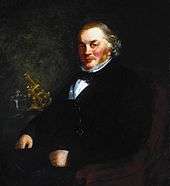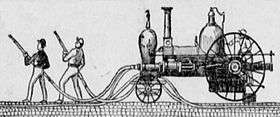Paul Rapsey Hodge
Paul Rapsey Hodge (15 July 1808 – 1871) was an English-American inventor and mechanical engineer. He also worked as a writer of technical manuals in both the United States and England.

Biography
Hodge was born on 15 July 1808, at St. Austell in Cornwall, south west England. He emigrated to the United States around 1836 and initially worked as a draftsman for the locomotive builder Thomas Rogers in Paterson, New Jersey.[1]

Under the sponsorship of an insurance company,[2] in 1840–1841, Hodge designed and built the first fire engine in the United States[upper-alpha 1] that was steam powered.[1][4][5][6][7] It was also the first self-propelled fire engine; the engine used a dog clutch on the rear axle for movement, navigation, and steering.[6] It could throw a jet of water of 290 tons per hour (about 20 US gallons (76 l) per second) 166 ft 0 in (50.60 m) high.[3][7] The horizontal cylinders lined up with the pump cylinders and worked with a pair of driving wheels. At the front axle, ahead of the smoke-box, was an air vessel that activated a bell. In 1896 the fire engine was reported to have weighed around 7 or 8 tons, and was 13 ft .5 in (3.98 m) long. The large back wheels of the fire engine were lifted off the ground by a built-in jackscrew when pumping water for use on a fire, whereupon they served as flywheels for the engine as it pumped.[6]
Hodge's fire engine was unpopular with the Pearl Hose Company #28 of the New York City firefighters because its weight made it unwieldy to move down the streets.[5][6] It was ultimately sold to another fire department and used as a stand-alone pumping engine that was not self-propelled.[1] This was the only fire engine built by Hodge. No progress was made in that direction by anyone in the following decade.[7] In 1847 Hodge moved back to England and became an eminent engineer there. His business address at the time was 140 Strand in London. One of his business activities was as a writer of technical manuals of steam engines.[1]
Patents
Hodge patented some 16 inventions. These included devices for grinding wheat, regulating springs in railway cars,[8] machinery for processing of felted cloth, machinery for brewing liquors, papermaking machinery, machinery that produced dinnerware, improvements in machinery technology for smelting of glass, metal, and porcelain. He also made improvements to machinery that made pigments for ink, gas lighting, and waterproofing of fabrics.[1]
Works
- The Steam Engine – including a description of a locomotive engine that he made for Rogers Locomotive and Machine Works of Paterson, New Jersey (1840).[9] Hodge’s description of the Dunham Engine was little more than a listing of parts.[10] He mentioned that the usual steam pressure was 50 Pounds per square inch, and that the engine had been tested pulling a 220-ton train at 14 miles per hour up a slope.[10] This was the earliest work to contain a complete drawing of an American locomotive.[11] He worked for the Rogers Company on the locomotive Sandusky.[upper-alpha 2]
- Principles and Application of the Steam Engine (1849).[13]
Societies
Hodge was a member of the Institution of Civil Engineers and the Institution of Mechanical Engineers.[1]
Death
Hodge died in 1871.[1]
See also
References
Notes
- Antedating this steam fire engine by a decade, in England the Braithwaite and Ericsson company had produced a firetruck that weighed two tons, and put out 40 tons of water per hour to a height of 90 ft 0 in (27.43 m).[3]
- While working for the Rogers Company on the Sandusky, his drawings were so poorly executed that the firebox would not fit into the boiler shell. He was terminated for incompetence as a result.[12]
Citations
- Grace's Guide to British Industrial History. "Paul Rapsey Hodge". Who's Who in Engineering. Grace's Guide Ltd. Retrieved 19 March 2017.
- "The Development of American Industries Since Columbus: Fire Fighting I", Popular Science Monthly, 47 (August 1895), p. 491, 1895,
The first steam fire engine ever built or used in the United States was one made by Mr. Paul R. Hodge for the Matteawan Insurance Company, of New York.
- "First steam engine used in the United States". Deseret Evening News. Salt Lake City, Utah. 19 July 1902 – via newspapers.com

- Lyons 1976, p. 71.
- Kane 1997, p. 272.
- King 2001, pp. 4–5.
- "Putting Out Fires". Santa Cruz Sentinel. Santa Cruz, California. 14 July 1903 – via newspapers.com

- Hodge, Paul Raysey. "On a new self lubricating axle-box for railway engines and carriages, and a self acting spring crossing point". Proceedings of the Society of Mechanical Engineers. p. 213. Retrieved 2 March 2017.
- Hodge 1840.
- White 1979, p. 280.
- White 1979, p. 491.
- White1979, p. 281.
- Hodge 1849.
Bibliography
- Hodge, Paul Rapsey (1840). The Steam Engine – including a description of a locomotive engine that he made for Rogers Locomotive and Machine Works of Paterson, New Jersey. D. Appleton & Company. Retrieved 19 March 2017 – via Internet Archive.CS1 maint: ref=harv (link)
- Hodge, Paul Rapsey (1849). Principles and Application of the Steam Engine. D. Appleton & Company. Retrieved 19 March 2017 – via Internet Archive.CS1 maint: ref=harv (link)
- Kane, Joseph Nathan (1997). Famous first facts. H.W. Wilson. ISBN 978-0-8242-0930-8.
The first fire engine with a steam boiler was designed and built by Paul Rapsey Hodge and publicly tested on March 27, 1841, at the City Hall, New York City. It was 14 feet long and weighed about 8 tons. It had two small wheels under the boiler in front and two huge wheels at the rear. Two horses were required to draw it on level ground. It was placed in service by the fire company known as Pearl Hose No. 28, but was abandoned because it was too heavy and because sparks poured from its stacks.
CS1 maint: ref=harv (link) - King, William T. (2001) [1896]. History of the American Steam Fire-Engine (Dover ed.). Mineola, N.Y: Dover Publications. pp. 4–5. ISBN 0-486-41530-9 – via Google books.CS1 maint: ref=harv (link)
- Lyons, Paul R. (1976). Fire in America!. National Fire Protection Association.
The first steam fire engine in the United States was designed and constructed at the instigation of insurance companies in 1840 by P. R. Hodge, C. E., an ingenious mechanical engineer of New York City.
CS1 maint: ref=harv (link) - White, John H., Jr. (1979) [1968]. A History of the American Locomotive. Johns Hopkins Press, Dover Publications. ISBN 0486238180. ISBN 9780486238180.CS1 maint: ref=harv (link)